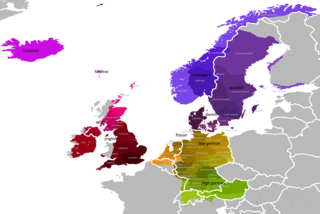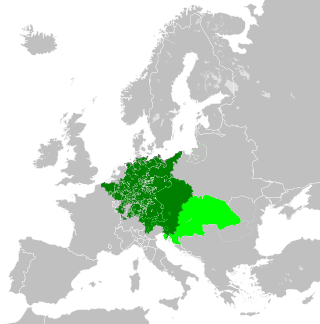
A diacritic is a glyph added to a letter or to a basic glyph. The term derives from the Ancient Greek διακριτικός, from διακρίνω. The word diacritic is a noun, though it is sometimes used in an attributive sense, whereas diacritical is only an adjective. Some diacritics, such as the acute ⟨á⟩, grave ⟨à⟩, and circumflex ⟨â⟩, are often called accents. Diacritics may appear above or below a letter or in some other position such as within the letter or between two letters.

The Germanic languages are a branch of the Indo-European language family spoken natively by a population of about 515 million people mainly in Europe, North America, Oceania and Southern Africa. The most widely spoken Germanic language, English, is also the world's most widely spoken language with an estimated 2 billion speakers. All Germanic languages are derived from Proto-Germanic, spoken in Iron Age Scandinavia and Germany.

German is a West Germanic language in the Indo-European language family, mainly spoken in Western and Central Europe. It is the most widely spoken and official or co-official language in Germany, Austria, Switzerland, Liechtenstein, and the Italian province of South Tyrol. It is also an official language of Luxembourg and Belgium, as well as a recognized national language in Namibia. There further exist notable German-speaking communities in France (Alsace), the Czech Republic, Poland, Slovakia, Denmark, Romania and Hungary (Sopron).

Old Norse, Old Nordic, or Old Scandinavian is a stage of development of North Germanic dialects before their final divergence into separate Nordic languages. Old Norse was spoken by inhabitants of Scandinavia and their overseas settlements and chronologically coincides with the Viking Age, the Christianization of Scandinavia and the consolidation of Scandinavian kingdoms from about the 8th to the 15th centuries.
A passive voice construction is a grammatical voice construction that is found in many languages. In a clause with passive voice, the grammatical subject expresses the theme or patient of the main verb – that is, the person or thing that undergoes the action or has its state changed. This contrasts with active voice, in which the subject has the agent role. For example, in the passive sentence "The tree was pulled down", the subject denotes the patient rather than the agent of the action. In contrast, the sentences "Someone pulled down the tree" and "The tree is down" are active sentences.

Reich is a German noun whose meaning is analogous to the English word "realm"; this is not to be confused with the German adjective "reich" which means "rich". The terms Kaiserreich and Königreich are respectively used in German in reference to empires and kingdoms. The Cambridge Advanced Learner's Dictionary indicates that in English usage, the term "Third Reich" refers to "Germany during the period of Nazi control from 1933 to 1945".
The Germanic umlaut is a type of linguistic umlaut in which a back vowel changes to the associated front vowel (fronting) or a front vowel becomes closer to (raising) when the following syllable contains, , or.

A loanword is a word at least partly assimilated from one language into another language, through the process of borrowing. Borrowing is a metaphorical term that is well established in the linguistic field despite its acknowledged descriptive flaws: nothing is taken away from the donor language and there is no expectation of returning anything.

Ö, or ö, is a character that represents either a letter from several extended Latin alphabets, or the letter "o" modified with an umlaut or diaeresis. Ö, or ö, is a variant of the letter O. In many languages, the letter "ö", or the "o" modified with an umlaut, is used to denote the close- or open-mid front rounded vowels or. In languages without such vowels, the character is known as an "o with diaeresis" and denotes a syllable break, wherein its pronunciation remains an unmodified.
German orthography is the orthography used in writing the German language, which is largely phonemic. However, it shows many instances of spellings that are historic or analogous to other spellings rather than phonemic. The pronunciation of almost every word can be derived from its spelling once the spelling rules are known, but the opposite is not generally the case.
Über is a German language word meaning "over", "above" or "across". It is an etymological twin with German ober, and is a cognate with English over, Dutch over, Swedish över and Icelandic yfir, among other Germanic languages; it is a distant cognate to the Sanskrit word ūpari and Hindi ūpar, probably through Proto-Indo-European. The word is relatively well known within Anglophone communities due to its occasional use as a hyphenated prefix in informal English, usually for emphasis. The German word is properly spelled with an umlaut, while the spelling of the English loanword varies.
In linguistics, a compound is a lexeme that consists of more than one stem. Compounding, composition or nominal composition is the process of word formation that creates compound lexemes. Compounding occurs when two or more words or signs are joined to make a longer word or sign. Consequently, a compound is a unit composed of more than one stem, forming words or signs. If the joining of the words or signs is orthographically represented with a hyphen, the result is a hyphenated compound. If they are joined without an intervening space, it is a closed compound. If they are joined with a space, then the result – at least in English – may be an open compound.
English rarely uses diacritics, which are symbols indicating the modification of a letter's sound when spoken. Most of the affected words are in terms imported from other languages. The two dots accent, the grave accent and the acute accent are the only diacritics native to Modern English, and their usage has tended to fall off except in certain publications and particular cases.
A-mutation is a metaphonic process supposed to have taken place in late Proto-Germanic.
The grammar of Old English differs considerably from Modern English, predominantly being much more inflected. As a Germanic language, Old English has a morphological system similar to that of the Proto-Germanic reconstruction, retaining many of the inflections thought to have been common in Proto-Indo-European and also including constructions characteristic of the Germanic daughter languages such as the umlaut.
Tweants is a group of non-standardised, closely related Westphalian, Dutch Low Saxon dialects, descending from Old Saxon.
The nouns of the German language have several properties, some unique. As in many related Indo-European languages, German nouns possess a grammatical gender; the three genders are masculine, feminine, and neuter. Words for objects without obvious masculine or feminine characteristics like 'bridge' or 'rock' can be masculine or feminine. German nouns are declined depending on their grammatical case and whether they are singular or plural. German has four cases: nominative, accusative, dative and genitive.
The vocabulary of the Icelandic language is heavily derived from and built upon Old Norse and contains relatively few loanwords; where these do exist their spelling is often heavily adapted to that of other Icelandic words.
A Germanism is a loan word or other loan element borrowed from German for use in some other language.

Umlaut is a name for the two dots diacritical mark as used to indicate in writing the result of the historical sound shift due to which former back vowels are now pronounced as front vowels.











